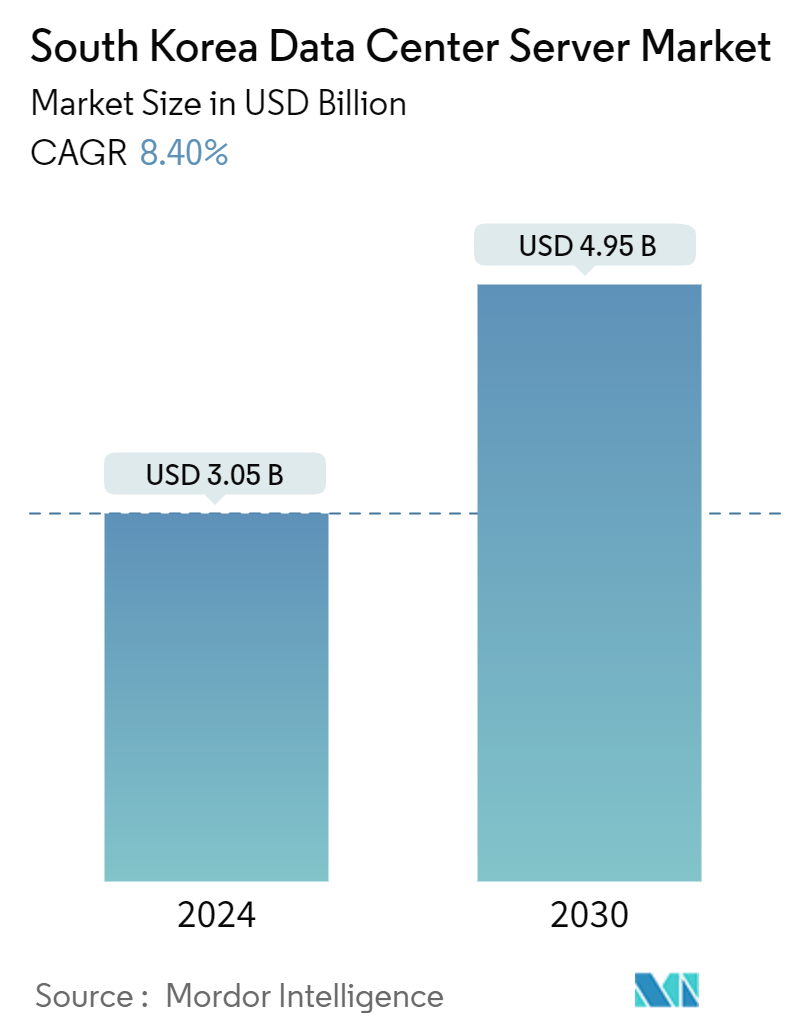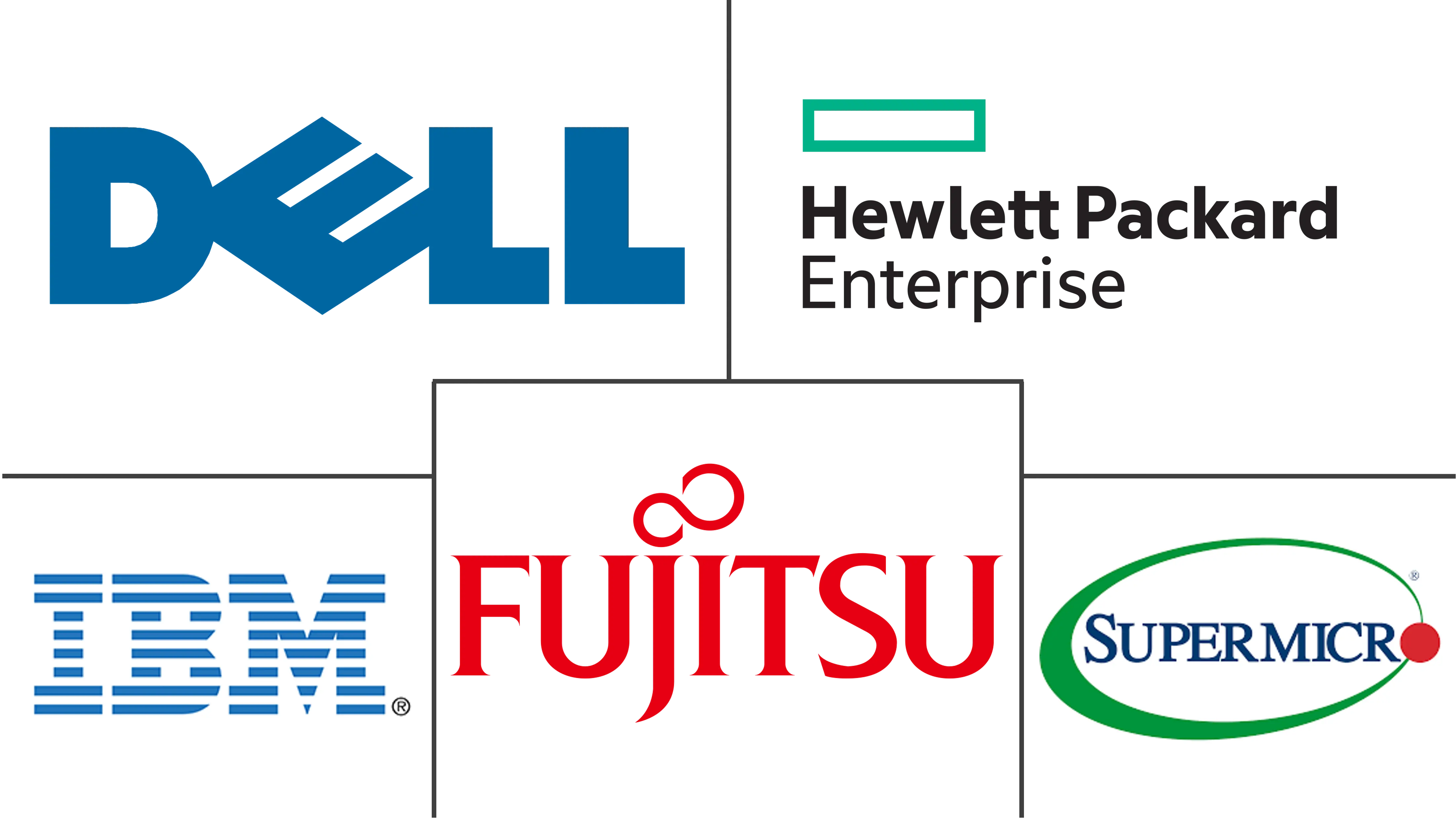Market Size of South Korea Data Center Server Industry

| Study Period | 2019 - 2030 |
| Base Year For Estimation | 2023 |
| Market Size (2024) | USD 3.05 Billion |
| Market Size (2030) | USD 4.95 Billion |
| CAGR (2024 - 2030) | 8.40 % |
| Market Concentration | High |
Major Players
*Disclaimer: Major Players sorted in no particular order |
South Korea Data Center Server Market Analysis
The South Korea Data Center Server Market size is estimated at USD 3.05 billion in 2024, and is expected to reach USD 4.95 billion by 2030, growing at a CAGR of 8.40% during the forecast period (2024-2030).
The South Korea data center server market reached a value of USD 2.6 billion in the previous years, and it is further projected to register a CAGR of 8.4% during the forecast period. The increasing demand for cloud computing among (small and medium-sized enterprises) SMEs, government regulations for local data security, and growing investment by domestic players are some of the major factors driving the demand for data centers in the country/region.
- Under Construction IT Load Capacity: The upcoming IT load capacity of the South Korea data center market is expected to reach 2045.3 MW by 2029.
- Under Construction Raised Floor Space: The country's construction of raised floor area is expected to increase to 5.7 million sq. ft by 2029.
- Planned Racks: The country's total number of racks to be installed is expected to reach 285.8K units by 2029. Greater Seoul is expected to house the maximum number of racks by 2029.
- Planned Submarine Cables: There are close to 10 submarine cable systems connecting South Korea, and many are under construction. One such submarine cable that is estimated to start service in 2025 is Bridge One, which stretches over 330 Kilometers with landing points from Pohang, South Korea.
South Korea Data Center Server Industry Segmentation
A data center server is basically a high-capacity computer computer without peripherals like monitors and keyboards. It is a hardware unit installed inside a rack, having a central processing unit (CPU), storage, and other electrical and networking equipment, making them powerful computers that deliver applications, services, and data to end-user devices.
The South Korea data center server market is segmented by form factor (blade server, rack server, and tower server) and by end-user (IT and telecommunication, BFSI, government, media and entertainment, and other end-users). The market sizes and forecasts are provided in terms of value (USD) for all the above segments.
| Form Factor | |
| Blade Server | |
| Rack Server | |
| Tower Server |
| End-User | |
| IT & Telecommunication | |
| BFSI | |
| Government | |
| Media & Entertainment | |
| Other End-User |
South Korea Data Center Server Market Size Summary
The South Korea data center server market is experiencing significant growth, driven by the increasing demand for cloud computing, particularly among small and medium-sized enterprises, and the need for enhanced data security regulations. The market is also benefiting from substantial investments by domestic players and the government's initiatives to bolster digital infrastructure. The rise of online banking and mobile payment systems has further fueled the demand for data centers, as they provide the necessary high-speed connectivity and processing power to support real-time transactions. The banking, financial services, and insurance sectors are particularly poised for growth, with plans to transform Seoul into a fintech test bed, which is expected to increase the demand for data centers and servers.
The market is characterized by a preference for rack servers due to their cost-effectiveness and efficiency in space-constrained environments. The Korean government's efforts to lower barriers for cloud computing services are attracting foreign tech giants, which is anticipated to drive demand for rack servers. The government's Digital Government Masterplan and investments in modern infrastructure are expected to further boost data center construction. The market is consolidated, with major players like Hewlett Packard Enterprise, Dell Inc., and IBM Korea Inc. focusing on expanding their market share through strategic collaborations. Recent advancements in server technology, such as those announced by Supermicro, Inc. and Inspur Information, highlight the ongoing innovation and competitive dynamics within the market.
South Korea Data Center Server Market Size - Table of Contents
-
1. Market Dynamics
-
1.1 Market Overview
-
1.2 Market Drivers
-
1.2.1 Government Rollout Towards Fiber Connectivity and 5G Deployment
-
1.2.2 Adoption of Digital Banking
-
-
1.3 Market Restraints
-
1.3.1 High CaPex for Building Data Center Along With Security Challenges
-
-
1.4 Value Chain / Supply Chain Analysis
-
1.5 Industry Attractiveness - Porter's Five Forces Analysis
-
1.5.1 Threat of New Entrants
-
1.5.2 Bargaining Power of Buyers/Consumers
-
1.5.3 Bargaining Power of Suppliers
-
1.5.4 Threat of Substitute Products
-
1.5.5 Intensity of Competitive Rivalry
-
-
1.6 Assessment of COVID-19 Impact
-
-
2. MARKET SEGMENTATION
-
2.1 Form Factor
-
2.1.1 Blade Server
-
2.1.2 Rack Server
-
2.1.3 Tower Server
-
-
2.2 End-User
-
2.2.1 IT & Telecommunication
-
2.2.2 BFSI
-
2.2.3 Government
-
2.2.4 Media & Entertainment
-
2.2.5 Other End-User
-
-
South Korea Data Center Server Market Size FAQs
How big is the South Korea Data Center Server Market?
The South Korea Data Center Server Market size is expected to reach USD 3.05 billion in 2024 and grow at a CAGR of 8.40% to reach USD 4.95 billion by 2030.
What is the current South Korea Data Center Server Market size?
In 2024, the South Korea Data Center Server Market size is expected to reach USD 3.05 billion.

